

The Magic of DADGAD Tuning. Explore Exotic Worlds with Sonic Safari Music.
Just another WordPress site. GR Symphony - a scale experiment by David M. Guillot. The 833 Cents Scale. An 833 Cents Scale An experiment on harmony Latest update: December 9,2012 Introduction Not every music theorist agrees that combination tones play a major role when it comes to defining harmony.
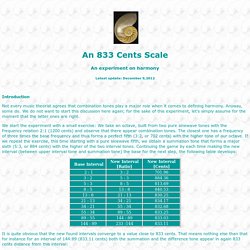
41 equal temperament. In music, 41 equal temperament, abbreviated 41-tET, 41-EDO, or 41-ET, is the tempered scale derived by dividing the octave into 41 equally sized steps (equal frequency ratios).

Play ), an interval close in size to the septimal comma. 41-ET can be seen as a tuning of the schismatic,[1] magic and miracle[2] temperaments. It is the second smallest equal temperament, after 29-ET, whose perfect fifth is closer to just intonation than that of 12-ET. In other words, is a better approximation to the ratio than either or History and use[edit]
Microtonality, Tunings and Modes. There is still a lot of good music waiting to be written in C major. — Arnold Schönberg One of the most liberating aspects about using a computer to compose music is that non-traditional “frequency space” can be explored in different ways without having to address the limitations of physical instruments or human performers.
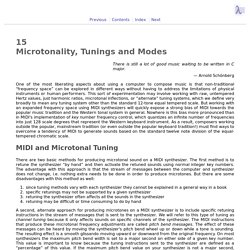
This sort of experimentation may involve working with raw, untempered Hertz values, just harmonic ratios, microtonal inflections, or “alternate” tuning systems, which we define very broadly to mean any tuning system other than the standard 12-tone equal tempered scale. But working with an expanded frequency space using MIDI synthesizers will quickly expose a strong bias of MIDI towards the popular music tradition and the Western tonal system in general. MIDI and Microtonal Tuning There are two basic methods for producing microtonal sound on a MIDI synthesizer. Channel Tuning Note by note tuning.
31. Microtonal Bach Experiment - Which Tuning Sounds Better? A note on the naming of musical intervals. A note on the naming of musical intervals by David C Keenan, 29-Nov-1999 last updated 3-Nov-2001 Acknowledgements I pieced together the following scheme for naming 11-limit intervals by taking various people's casual usage on the alternative tuning list, and the English names that Manuel Op de Coul uses in Scala ( and then pushing and prodding them until I obtained a reasonably consistent and self-explanatory system.
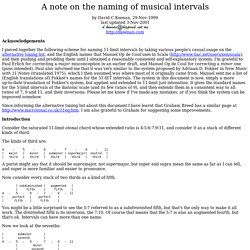
WebCite query result. Music Theory from Paul Erlich. Some music theory from Paul Erlich The Forms of Tonality erlich-tFoT.pdf (408K) paper with inline images A Middle Path MiddlePath2015.pdf (11 MB) paper with inline images.

Encyclopedia of Microtonal Music-Theory. Microtonal and just intonation composers and theorists have recently been working to re-establish the connection between math and music through the development of microtonal music theory.

This vibrant, growing community of microtonal music theorists, composers, and software developers has been making tremendous contributions to our knowledge and understanding of a variety of topics in contemporary and historic music theory: Just-intonation scales, chords, and chord progressions New musical scales and tuning-systems based on the expanded resources of musical pioneers such as Partch, Fokker, and Wilson. Microtonal Modes and Scales from the Middle East and Central Asia. Tune Smithy - fractal music generator and microtonal composition tool - Software for Windows. Overview of Tune Smithy To get back here click on Music What do you want to do with Fractal Tune Smithy?
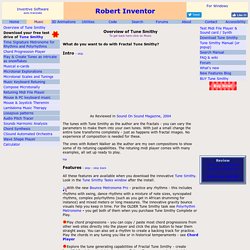
Intro - skip As Reviewed in Sound On Sound Magazine, 2004 The tunes with Tune Smithy as the author are the fractals - you can vary the parameters to make them into your own tunes. How to invent your own musical scales using Scala - Sevish Music. Microtonality, Tunings and Modes. Egyptian Fractions. 1 Egyptian Fractions The ancient Egyptians only used fractions of the form 1/n so any other fraction had to be represented as a sum of such unit fractions and, furthermore, all the unit fractions were different!
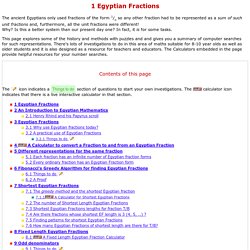
Why? Is this a better system than our present day one? In fact, it is for some tasks. Pythagorean tuning. The syntonic tuning continuum, showing Pythagorean tuning at 702 cents.[1] Diatonic scale on C Play 12-tone equal tempered and Play just intonation.
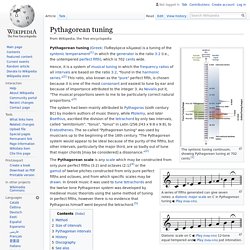
Where Math meets Music. Where Math meets Music Ever wonder why some note combinations sound pleasing to our ears, while others make us cringe?
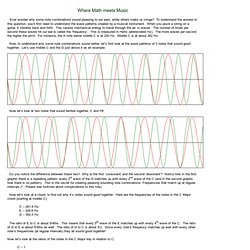
To understand the answer to this question, you’ll first need to understand the wave patterns created by a musical instrument. When you pluck a string on a guitar, it vibrates back and forth. This causes mechanical energy to travel through the air, in waves. The number of times per second these waves hit our ear is called the ‘frequency’. Now, to understand why some note combinations sound better, let’s first look at the wave patterns of 2 notes that sound good together. Now let’s look at two notes that sound terrible together, C and F#: LucyTuning*LucyScaleDevelopments*Pi tuning*LucyTuned Lullabies*John "Longitude" Harrison. Setting tuning and harmonic standards into the future. Have fun with them. LucyTuned Lullabies (from around the world) New LucyTune site (May 2005) BBC Radio 4 interview with Robert Sandall about LucyTuning mp3 - (3min 54 seconds) LucyTuning - musical tuning, harmonic, composition, practice, specifications, and theory.
Here’s Why You Should Convert Your Music To 432 Hz. “If you want to find the secrets of the universe, think in terms of energy, frequency and vibration.” – Nikola Tesla“What we have called matter is energy, whose vibration has been so lowered as to be perceptible to the senses. There is no matter.” – Albert Einstein Tesla said it. Einstein Agreed. Science proved it. It is a known fact that everything—including our own bodies—is made up of energy vibrating at different frequencies. The science of Cymatics illustrates that when sound frequencies move through a particular medium such as water, air or sand, it directly alters the vibration of matter.
Water memory also illustrates how our own intentions can even alter the material world. We all hold a certain vibrational frequency, not to mention our bodies are estimated to be about 70% water… so we can probably expect that musical frequencies can alter our own vibrational state. Music Frequency. Microtonality, Tunings and Modes.
Danielou Universal Scale. Each entry includes the ratio, cents error relative to nearest tempered (so, for example, 3/2 is +2.0c relative to note #42), tempered note # (0-71), keyboard # (0-5), key # (0-11), where keyboards 1 -5 are~ assumed progressively [17¢ globally] sharper relative to keyboard 0 [which are all 12-tET]. Tues., 1 May 2001 from "Canright, David" www.alaindanielou.org Maurice Courant allows himself to write: "Needless to say, the sixty degrees in the octave are scarcely perceptible and are difficult to realize, a slight difference of temperature bringing a significant variation in the sound compared with the interval of two successive degrees.
Such a scale can never be accurate. " Courant, Maurice. . . . An Infinite Continuum of Music. More Complicated Temperaments. Before equal temperament was generally adopted, other schemes were used which allowed music to be played in all twelve keys with acceptable results, even if each key had its own unique flavor. One example of this is the Valotti temperament. In this temperament, the notes from F through B on the circle of fifths are tuned in relation to each other according to a 1/6-comma meantone temperament. However, for reasons to be explained shortly, the comma used in these schemes needs to be understood as a Pythagorean comma, rather than a syntonic comma.
The Creation of the Musical Scale. The Creation of Musical Scales. Anatomy of an Octave. LucyTuning*LucyScaleDevelopments*LucyTuned Lullabies*Pi tuning*John Longitude Harrison. Cmj98. XENTONALITY. Every sound has an internal structure that determines its tone quality or timbre. When the larger structure of the music (the musical scale) reflects this internal structure, then the timbre and the tuning are related in a fundamental way. XENTONALITY. Bohlen–Pierce scale. Chord from just Bohlen–Pierce scale: C-G-A, tuned to harmonics 3, 5, and 7.
"BP" above the clefs indicates Bohlen–Pierce notation. Play. Temperaments and tuning systems. Temperament: A Beginner's Guide. Temperament: A Beginner's Guide Stephen Bicknell oneskull@dircon.co.uk April 25, 1997 Revised May 14, 1997.
Partch. An Introduction to Historical Tunings. Or if G vibrates at 100 cycles per second, then B vibrates at 125, and so on. Relating Tuning and Timbre. This is the full text of the article (more or less) as it first appeared in Experimental Musical Instruments. It was the catalyst for much of the work that resulted in Tuning Timbre Spectrum Scale, and it contains links to computer programs that will make it easy for you to draw dissonance curves yourself. Makam. Makam (pl. makamlar; from the Arabic word مقام) is a system of melody types used in Turkish classical music. Tuning Timbre Spectrum Scale. By William A.